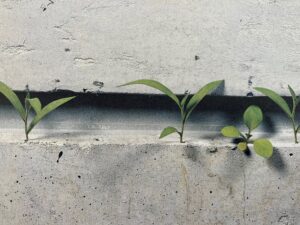
Matthew 21:1-11
There is a film called The Banshees of Inisherin about a man named Padraic. He is a sweet, gentle guy. He lives on a little island off the coast of Ireland, sharing a cottage with his sister, Siobhan, who loves him. Padraic has a friend Colm, who he thinks loves him, and life is fine – until it isn’t.
Something that is said again and again throughout the story is that Padraic always thought of himself as one of the good ones; never harmed anyone, always a kind word for everyone. But when he gets pushed hard enough, it turns out he is capable of some pretty horrific things.
Padraic is changed through the course of this story. But in the end, he’s not a different person. He is just showing something that has always been inside of him.
It was unexpected. But, in truth, it’s something that is inside of all of us, if we are truthful; all of us who think of ourselves as the good ones.
The good ones. Unlike those others we can point to who are not the good ones.
Someone asked me weeks ago if I was ready for Lent and I said I was as ready as I ever am, ready as I can be for something that fills me with fear and trembling. Because the season of Lent is a season in which we are asked to descend into death. To look at death straight on, with eyes open, with honest hearts.
And to look at ourselves the same way – straight on, eyes open, honestly. That is where the fear and trembling come in. Because when I look at myself that way I have to see the violence in me. I have to see the places I have allowed hate to fester. I have to see the ways in which I am complicit in the suffering in the world.
I don’t want to see it. I would much rather think of myself as one of the good ones.
The past two weeks have been a particularly difficult part of our Lenten journey. We saw the death of two of our beloved members. Even though we have faith that they now dwell in the joy of our Lord, it is still hard. Death is a painful and hard thing to endure, it is a wrenching separation.
In this week as we were saying goodbye to these friends, we experienced another wrenching catastrophe in Nashville – one more slaughter of the innocent children. Could it be? In the days since, I have grieved. And I have subjected myself to further punishment by reading the news.
Again and again I have read about elected officials saying in one way or another: I can’t do anything about that.
Reporters badger senators in the halls of congress and they continue walking, letting us know they’re tired of the subject. When the man who represents Nashville in congress was asked what could be done about this, he said “Nothing. We’re not going to fix it.”
When a senator was asked if they would take up any gun control legislation, she said, “there isn’t any appetite for that.”
I wonder. Is it possible that valuing the lives of our children over our guns is distasteful? How does that happen?
I am aware that violence is nothing new in our society. Jesus lived in a time and place where violence was endemic, too, just as it is here. One difference, of course, was that no one had AR-15s. Although, one congresswoman said that if only Jesus did have some AR-15s he wouldn’t have been crucified.
I suppose it was meant as a joke. But I’m afraid the whole meaning of the gospel is lost here.
Jesus lived in a time of violence and he spoke against it. He spoke God’s truth to the powers of this world. He was at times confrontational; he was bold to call out hypocrisy and evil. But one thing he did not do: he did not take up violence in response to the violence around him.
There were others who did respond to violence with violence. But Jesus, in his every word and deed, showed us a different way, an unexpected way.
On that first Palm Sunday, he rode into the city of Jerusalem seated on a lowly donkey, greeted by a glad and grateful crowd – it was a triumph of humility. Not force, not threat; this was a king of peace.
And the people shouted to him, “Save us!”
Save us from ourselves.
When we dare to look inside ourselves with eyes open, with honesty, we confront the violence that lives in us, the potential that is there.
In the 1960s the artist Andy Warhol, who was known for his pop art depictions of soups cans and other objects, began depicting scenes of violence and death. He did car crashes, plane crashes, people rioting in opposition to civil rights.
It was unexpected, but perhaps it shouldn’t have been. This was a time of increasing US involvement in the war in Vietnam and rising conflict at home over civil rights. And it was all on our TV screens day after day. Warhol was always a sharp observer of culture and he reflected it right back at us with his photographs and paintings. It was distasteful.
And then he did the electric chair series.
I first became aware of this when I visited the Warhol museum in Pittsburgh. There was an exhibit of his photographs of an electric chair, which he had tinted in a variety of colors: pink, yellow, orange, and lavender.
The exhibit was titled, Electric Chair in New Spring/Easter Colors.
It was an interesting, provocative thing to do. The display of framed pictures was attractive, in a way. The colors were pretty. The chair, itself, is crude, to say the least – but when it’s not actually in use it looks pretty benign.
Kind of like the cross.
On the first Palm Sunday, the people in Jerusalem were not thinking about the cross – they were thinking about glory. It was only later that we all discovered the way to glory passes through the cross.
The way to love is through sacrifice. The way to life is through death.
Every year at this time I remember the words of William Penn:
No pain, no palm;
no thorns, no throne;
no gall, no glory;
no cross, no crown.
Always, the unexpected.
May we enter this holy week looking for our triumph, looking for the ultimate love, in the unexpected places.
